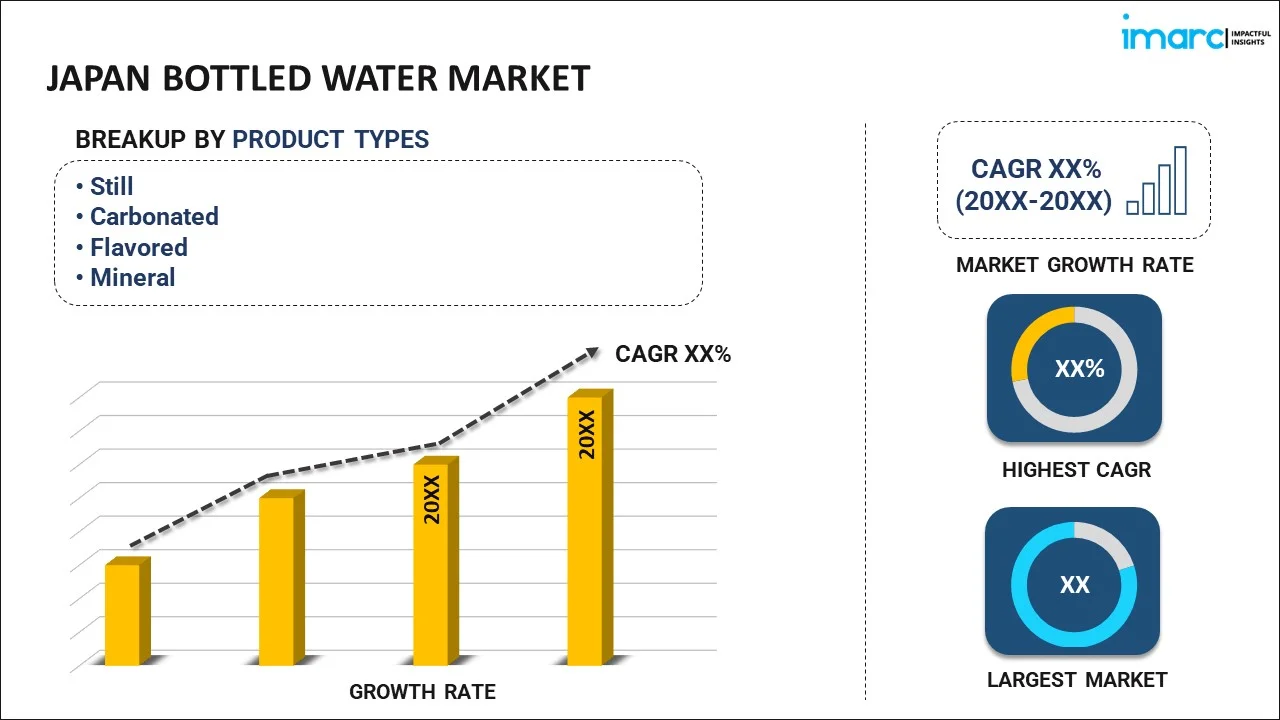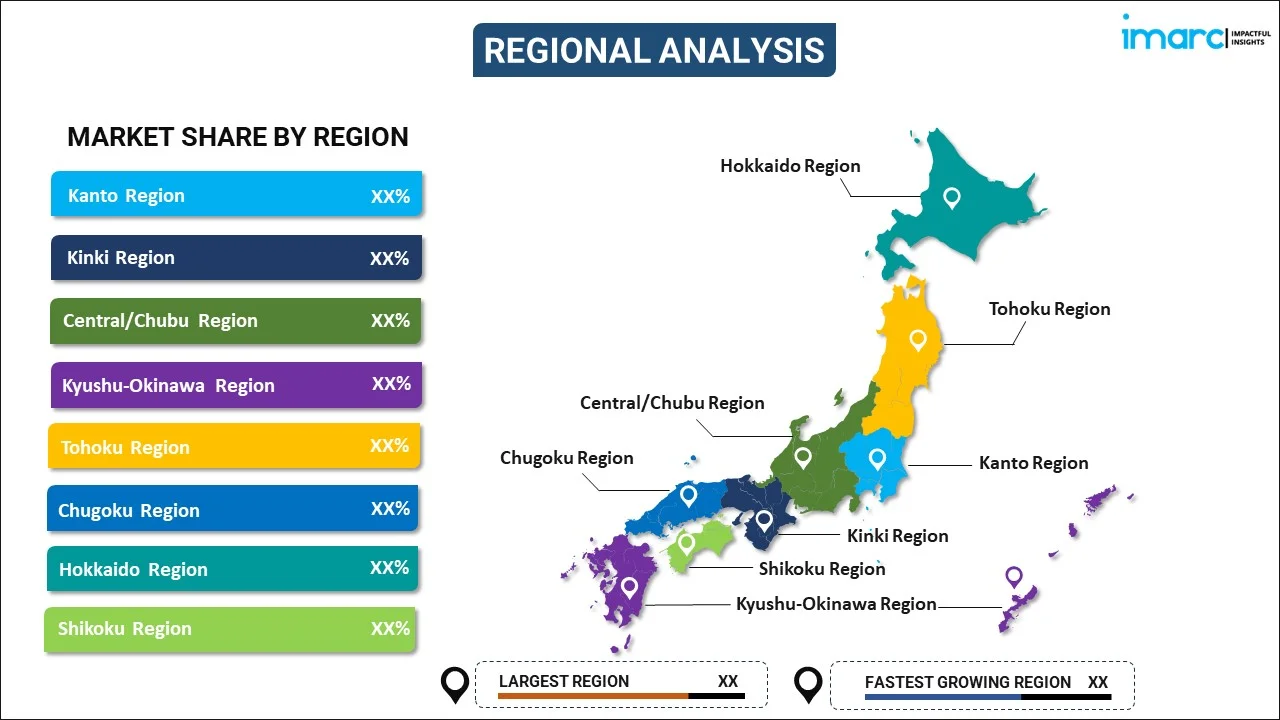
Japan Bottled Water Market Report by Product Type (Still, Carbonated, Flavored, Mineral), Distribution Channel (Supermarkets and Hypermarkets, Convenience Stores, Direct Sales, On-Trade, and Others), Packaging Type (PET Bottles, Metal Cans, and Others), and Region 2025-2033
Market Overview:
The Japan bottled water market size reached USD 15.5 Billion in 2024. Looking forward, IMARC Group expects the market to reach USD 23.7 Billion by 2033, exhibiting a growth rate (CAGR) of 4.5% during 2025-2033. The growing concerns about environmental sustainability, rising number of online channels that allow consumers to explore a wider range of bottled water types, including premium, flavored, and functional varieties, and increasing understanding about the benefits of clean and mineral-rich water for overall health are some of the factors impelling the market growth.
|
Report Attribute
|
Key Statistics
|
|---|---|
|
Base Year
|
2024 |
|
Forecast Years
|
2025-2033
|
|
Historical Years
|
2019-2024
|
| Market Size in 2024 | USD 15.5 Billion |
| Market Forecast in 2033 | USD 23.7 Billion |
| Market Growth Rate (2025-2033) | 4.5% |
Bottled water is water that has been processed and packaged in plastic or glass containers for consumption. It's a popular beverage choice for those who prefer or require a portable and convenient water source. It can be sourced from springs, wells, or public water supplies and typically undergoes purification processes to remove contaminants and meet regulatory standards. These processes may include filtration, distillation, or reverse osmosis. The bottled water industry is regulated by governmental authorities, ensuring that the product is safe and meets specific quality criteria. Many consumers choose bottled water for its perceived purity, taste, and convenience, especially when traveling or in areas where tap water quality is questionable. It is available in various sizes and types, including still, sparkling, flavored, or mineral-enriched water. The bottled water market continues to grow globally, reflecting changing lifestyles and an emphasis on hydration and health. The Japan bottled water market share continues to grow as consumers prioritize health, convenience, and sustainability in their beverage choices.
Japan Bottled Water Market Trends:
Rise of Online Retail and Subscription Services
With the convenience of online shopping, consumers can easily purchase bottled water in bulk or sign up for regular home deliveries, eliminating the need for frequent store visits. This trend is attractive to busy households, offices, and elderly individuals who appreciate the convenience of regular orders. Subscription services not just provide discounts and exclusive product bundles but also allow users to customize delivery schedules, which helps to increase user loyalty. Additionally, online platforms allow consumers to explore a wider range of bottled water types, including premium, flavored, and functional varieties, which are only sometimes readily available in physical stores. Besides this, business-to-business (B2B) e-commerce platforms are playing a crucial role in driving bulk purchases by businesses, including hotels, restaurants, and corporate offices. As per the data provided by the Ministry of Economy, Trade and Industry (METI), in 2023, Japan's business-to-consumer (B2C) e-commerce market grew to 24.8 trillion yen, which is a 9.23% increase compared to the previous year. The B2B e-commerce market also saw notable growth, reaching 465.2 trillion yen, up 10.7% from the year before.
Environmental Sustainability Initiatives
The growing concerns about environmental sustainability are driving bottled water companies in Japan to adopt eco-friendly packaging and promote recycling efforts. Leading brands are exploring biodegradable materials, reducing plastic usage, and coming up with refillable bottle schemes for catering to environmentally conscious consumers. A notable trend is the rise of green packaging, where companies utilize plant-based plastics, recycled materials, and compostable packaging options to minimize environmental impact. This shift not only reduces carbon footprints but also aligns with government regulations aimed at reducing plastic waste. Besides this, collaborations with government and non-government organizations (NGOs) to promote recycling and waste reduction are strengthening the market growth. In 2023, the green packaging market in Japan achieved a size of USD 14.1 Billion, according to the data provided by the IMARC Group.
Growing Health and Wellness Consciousness
Individuals are becoming more mindful of their hydration habits and the quality of the water they consume. This trend is driven by a heightened understanding about the benefits of clean and mineral-rich water for overall health, including improved digestion, better skin health, and enhanced physical performance. Additionally, the aging population in Japan places a premium on maintaining health and wellness, further driving the demand for premium bottled water products that offer added benefits, such as electrolytes or enhanced mineral content. The shift towards healthier lifestyles is encouraging aged consumers to prefer bottled water over sugary beverages and artificial drinks. Based on the data provided by the Statistics Bureau of Japan, as of October 2023, Japan had a population of 36,227 thousand people who were aged 65 years and older, accounting for 29.1 percent of the total population.
Japan Bottled Water Market Segmentation:
IMARC Group provides an analysis of the key trends in each segment of the Japan bottled water market report, along with forecasts at the country level for 2025-2033. Our report has categorized the market based on product type, distribution channel, and packaging type.
Product Type Insights:

- Still
- Carbonated
- Flavored
- Mineral
The report has provided a detailed breakup and analysis of the market based on the product type. This includes still, carbonated, flavored, and mineral.
Distribution Channel Insights:
- Supermarkets and Hypermarkets
- Convenience Stores
- Direct Sales
- On-Trade
- Others
A detailed breakup and analysis of the market based on the distribution channel have also been provided in the report. This includes supermarkets and hypermarkets, convenience stores, direct sales, on-trade, and others.
Packaging Type Insights:
- PET Bottles
- Metal Cans
- Others
The report has provided a detailed breakup and analysis of the market based on the packaging type. This includes PET bottles, metal cans, and others.
Regional Insights:

- Kanto Region
- Kinki Region
- Central/ Chubu Region
- Kyushu-Okinawa Region
- Tohoku Region
- Chugoku Region
- Hokkaido Region
- Shikoku Region
The report has also provided a comprehensive analysis of all the major regional markets, which include Kanto Region, Kinki Region, Central/ Chubu Region, Kyushu-Okinawa Region, Tohoku Region, Chugoku Region, Hokkaido Region, and Shikoku Region.
Competitive Landscape:
The report has also provided a comprehensive analysis of the competitive landscape in the market. Competitive analysis such as market structure, key player positioning, top winning strategies, competitive dashboard, and company evaluation quadrant has been covered in the report. Also, detailed profiles of all major companies have been provided.
Japan Bottled Water Market News:
- January 2023: Emma Japan introduced the Emma Bottle, which utilizes far-infrared vibrations to enhance water with antioxidant qualities for anti-aging advantages. This technology refines water molecules, aiding in lowering cell oxidation.
Japan Bottled Water Market Report Coverage:
| Report Features | Details |
|---|---|
| Base Year of the Analysis | 2024 |
| Historical Period | 2019-2024 |
| Forecast Period | 2025-2033 |
| Units | Billion USD |
| Scope of the Report | Exploration of Historical and Forecast Trends, Industry Catalysts and Challenges, Segment-Wise Historical and Predictive Market Assessment:
|
| Product Types Covered | Still, Carbonated, Flavored, Mineral |
| Distribution Channels Covered | Supermarkets and Hypermarkets, Convenience Stores, Direct Sales, On-Trade, Others |
| Packaging Types Covered | PET Bottles, Metal Cans, Others |
| Regions Covered | Kanto Region, Kinki Region, Central/ Chubu Region, Kyushu-Okinawa Region, Tohoku Region, Chugoku Region, Hokkaido Region, Shikoku Region |
| Customization Scope | 10% Free Customization |
| Post-Sale Analyst Support | 10-12 Weeks |
| Delivery Format | PDF and Excel through Email (We can also provide the editable version of the report in PPT/Word format on special request) |
Key Questions Answered in This Report:
- How has the Japan bottled water market performed so far and how will it perform in the coming years?
- What has been the impact of COVID-19 on the Japan bottled water market?
- What is the breakup of the Japan bottled water market on the basis of product type?
- What is the breakup of the Japan bottled water market on the basis of distribution channel?
- What is the breakup of the Japan bottled water market on the basis of packaging type?
- What are the various stages in the value chain of the Japan bottled water market?
- What are the key driving factors and challenges in the Japan bottled water?
- What is the structure of the Japan bottled water market and who are the key players?
- What is the degree of competition in the Japan bottled water market?
Key Benefits for Stakeholders:
- IMARC’s report offers a comprehensive quantitative analysis of various market segments, historical and current market trends, market forecasts, and dynamics of the Japan bottled water market from 2019-2033.
- The research study provides the latest information on the market drivers, challenges, and opportunities in the Japan bottled water market.
- Porter's five forces analysis assist stakeholders in assessing the impact of new entrants, competitive rivalry, supplier power, buyer power, and the threat of substitution. It helps stakeholders to analyze the level of competition within the Japan bottled water industry and its attractiveness.
- Competitive landscape allows stakeholders to understand their competitive environment and provides an insight into the current positions of key players in the market.
Need more help?
- Speak to our experienced analysts for insights on the current market scenarios.
- Include additional segments and countries to customize the report as per your requirement.
- Gain an unparalleled competitive advantage in your domain by understanding how to utilize the report and positively impacting your operations and revenue.
- For further assistance, please connect with our analysts.
 Request Customization
Request Customization
 Speak to an Analyst
Speak to an Analyst
 Request Brochure
Request Brochure
 Inquire Before Buying
Inquire Before Buying




.webp)




.webp)












